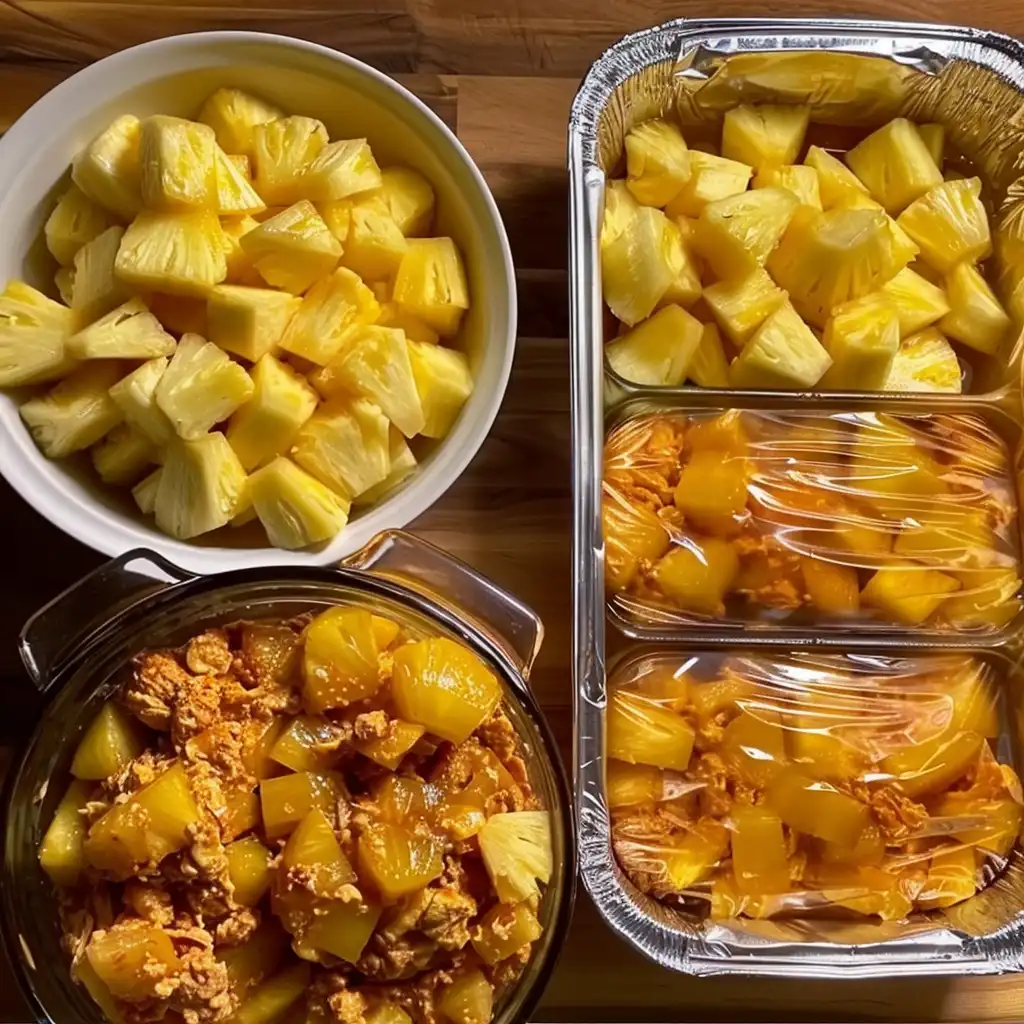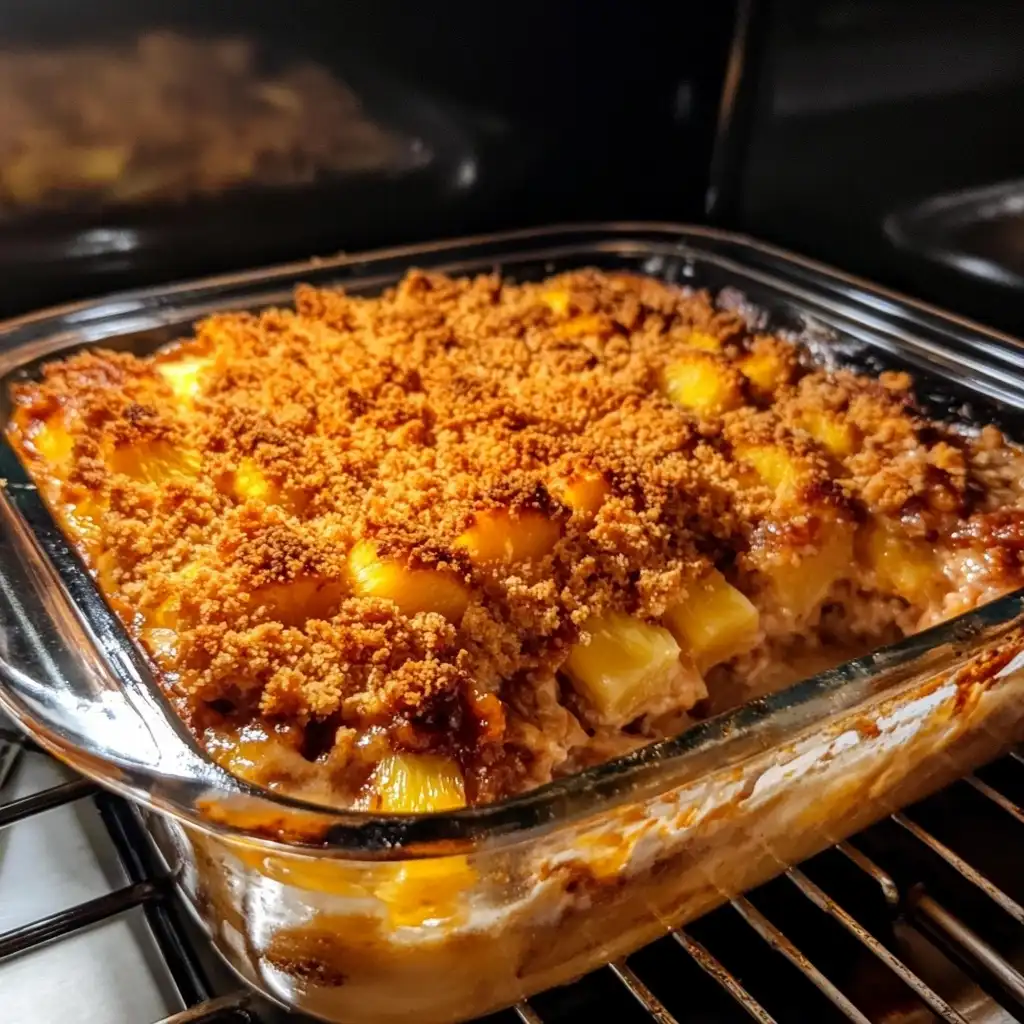Can You Freeze Pineapple Casserole? Best Practices & Storage Tips
Wondering if you can freeze pineapple casserole without ruining its texture? The answer is yes—if you follow the right steps. This Southern classic, with its sweet pineapple, tangy cheddar, and buttery crunch, can last up to 2 months in the freezer without losing its charm. But freeze it wrong, and you’ll get soggy crackers or a watery mess. In this guide, we’ll walk you through 5 easy steps to freeze, thaw, and reheat pineapple casserole perfectly—saving time, reducing waste, and keeping the flavor intact.
Why Freezing This Dish Can Save Time and Reduce Waste
Freezing food isn’t just about saving leftovers—it’s a game-changer for busy home cooks. Here’s why:
✔ Saves time – Make a double batch and freeze one for later.
✔ Reduces waste – Instead of tossing leftovers, freeze portions for future meals.
✔ Perfect for meal prep – Have a ready-to-bake dish for busy nights or unexpected guests.
Pineapple casserole freezes well when stored correctly, keeping its flavors intact for weeks. However, not every casserole ingredient reacts well to freezing. That’s why understanding how pineapple and cheese behave in the freezer is crucial.
What Happens to Pineapple and Cheese When Frozen?
When freezing pineapple casserole, you need to think about two key ingredients:
✅ Pineapple – Naturally high in water, pineapple can become icy in the freezer. When thawed, it releases extra liquid, which can make the casserole watery. Solution? Drain the pineapple well before freezing, and add a thickening agent like cornstarch to control moisture.
✅ Cheese – Cheddar holds up well in freezing, but it can become grainy or separate when thawed. The key is to mix the cheese well into the casserole before freezing, so it retains its creamy texture when reheated.
💡 Pro Tip: Avoid freezing casseroles with already-baked cracker toppings. They’ll turn soggy! Instead, add the topping fresh after reheating for the perfect crunch.
Common Mistakes to Avoid When Freezing Casseroles
Not all casseroles freeze the same way. If you want to freeze pineapple casserole without ruining it, avoid these common mistakes:
- Freezing the entire dish with the topping on – Crackers will turn soft and lose their crunch. Fix: Store the topping separately and add it after reheating.
- Skipping the draining step – Extra pineapple juice can make the casserole soggy. Fix: Drain well and even pat dry with paper towels if necessary.
- Using the wrong container – Poorly sealed containers lead to freezer burn and flavor loss. Fix: Use an airtight, freezer-safe container.
Now that we know what NOT to do, let’s go step by step on how to properly freeze pineapple casserole for the best results.
Can You Freeze Pineapple Casserole? What You Need to Know
Does Pineapple Casserole Freeze Well?
Yes, but only if frozen correctly. Since this dish has a mix of moist pineapple, creamy cheese, and a crispy topping, improper freezing can affect its texture.
Best Practice: Freeze the base separately and add the cracker topping fresh after reheating.
How long does it last in the freezer?
- Properly stored: Up to 2 months in an airtight container.
- Beyond 2 months: The flavor and texture start to decline.
Pro Tip: Label the container with the date and reheating instructions, so you don’t forget how long it’s been stored.
Why Freezing Works for Some Casseroles but Not Others
Not all casseroles freeze well. Some maintain their texture, while others become soggy. Here’s why it happens—and how to fix it:
Good for Freezing: Casseroles with a starchy base (like potatoes, pasta, or rice) hold up well. Pineapple casserole freezes well if prepped properly.
Not Great for Freezing: Dishes with egg-based fillings, cream-heavy sauces, or delicate greens tend to separate or become mushy after freezing.
Best Freezing Tip: If a casserole contains ingredients with high water content, like pineapple, always drain the liquid before freezing to prevent excess moisture when thawed.
The Best Freezer-Friendly Ingredients for Pineapple Casserole
If you plan to freeze pineapple casserole ahead of time, use ingredients that hold up well in the freezer.
✅ Best Ingredients for Freezing:
- Canned pineapple (drained) – Retains flavor better than fresh pineapple.
- Shredded cheddar cheese – Holds its texture if mixed into the casserole.
- Flour-based thickening agents – Helps stabilize the texture.
Fresh or canned, pineapple brings a unique sweetness to this casserole. Learn more about pineapple benefits!
Ingredients to Avoid Freezing:
- Pre-baked cracker topping – Becomes soggy.
- Too much added sugar – Sugar absorbs moisture and can create an odd texture.
Now that we’ve covered why freezing works and what ingredients freeze best, let’s get into the step-by-step freezing process.
How to Freeze Pineapple Casserole the Right Way
Step 1 – Choosing the Best Storage Container
The right container can make or break the freezing process.
✔ Best Options for Freezing:
- Airtight glass or plastic containers – Prevents freezer burn.
- Aluminum foil pans – Great for easy reheating (but wrap tightly with plastic wrap first).
- Vacuum-sealed freezer bags – If freezing individual portions.
Avoid using thin plastic containers that let air in. They cause freezer burn and can ruin the flavor of your food.
Step 2 – Prep the Casserole
Before freezing, you need to prepare the base properly to avoid excess moisture.
Drain the pineapple thoroughly, mix in cheese, sugar, and flour, and assemble in a freezer-safe dish—skip the cracker topping.
Pro Tip: Pat the pineapple dry with paper towels for even less moisture.
Step 3 – Freezing Baked vs. Unbaked Casseroles
You can freeze pineapple casserole baked or unbaked, but each has its pros and cons.
| Method | Pros | Cons |
|---|---|---|
| Freezing Unbaked | Keeps texture better when reheated | Takes longer to bake after thawing |
| Freezing Baked | Faster to reheat | May become softer over time |
Best Recommendation: If making ahead, freeze it unbaked and add the cracker topping fresh after reheating.
Want another freezer-friendly meal? Try this Pineapple Teriyaki Chicken—it’s easy to make and packed with flavor!
Thaw & Reheat Pineapple Casserole for a Fresh-Baked Taste
Freezing pineapple casserole is only half the battle—the real challenge is thawing and reheating it correctly to maintain its flavor, texture, and crunch. Do it wrong, and you’ll end up with a soggy mess or a dry, overcooked dish. Follow these steps to bring your frozen casserole back to life just like it was freshly made!

Step 4 – The Best Way to Thaw Frozen Pineapple Casserole
The way you thaw pineapple casserole directly affects its final texture. Since pineapple has high water content, thawing too quickly can cause excess moisture to pool in the dish.
✅ Best Thawing Method (Slow & Steady):
1️⃣ Remove the frozen casserole from the freezer and place it in the fridge.
2️⃣ Let it thaw overnight (8-12 hours).
3️⃣ Before reheating, check for excess liquid—drain any pooling moisture if necessary.
✅ Quick Thawing Method (If You’re in a Hurry):
1️⃣ Place the sealed casserole dish in a cold water bath for 1-2 hours.
2️⃣ Keep it covered to prevent direct moisture absorption.
3️⃣ Do NOT thaw at room temperature—this can lead to uneven defrosting and bacterial growth.
Pro Tip: If you froze the casserole without the cracker topping, now is the time to add fresh crushed crackers before baking for the crispiest results.

Step 5 – How to Reheat for a Freshly-Baked Taste
Once your pineapple casserole is thawed, it’s time to reheat it properly. The goal is to warm it through without drying it out.
Oven Method (Best for Even Heating & Crisp Topping)
- Preheat the oven to 350°F (175°C).
- Cover with foil and bake for 20-25 minutes if reheating an entire casserole.
- If you stored the topping separately, add it in the last 5-7 minutes for a golden, crispy finish.
- Remove foil and bake uncovered for 5 more minutes to crisp up the top.
Air Fryer Method (For Individual Portions)
- Preheat the air fryer to 325°F (163°C).
- Place a portion of the casserole in an oven-safe dish inside the air fryer.
- Heat for 6-8 minutes until bubbly and warm throughout.
Microwave Method (Fastest, But May Soften the Topping)
- Place a portion in a microwave-safe dish.
- Heat on medium power for 2-3 minutes, stirring halfway through.
- For crispier topping, transfer it to the oven or air fryer for 3-5 minutes after microwaving.
💡 Pro Tip: To refresh flavors, sprinkle a little shredded cheddar cheese on top before reheating!
FAQs About Freezing Pineapple Casserole
Is It Better to Freeze Casseroles Cooked or Uncooked?
It depends on how soon you plan to eat it.
✔ Freezing Uncooked Casserole (Best for Make-Ahead Meals)
- Pros: Holds texture better, fresh-tasting when baked.
- Cons: Takes longer to cook after thawing.
✔ Freezing Fully Baked Casserole (Best for Quick Reheating)
- Pros: Faster reheating, good for pre-made leftovers.
- Cons: Can become softer after thawing, so reheat uncovered to crisp up the topping.
Best Option? If freezing long-term, freeze it unbaked and bake fresh when ready to eat!
Can You Make a Casserole Ahead of Time and Freeze It?
Absolutely! Prepping and freezing a pineapple casserole ahead of time is a great way to save time.
How to Do It Right:
Prepare the casserole but keep it unbaked. Wrap it tightly with plastic wrap, followed by a layer of aluminum foil to prevent freezer burn. Store in the freezer for up to two months. When ready to enjoy, thaw it overnight in the refrigerator and bake fresh for the best texture and flavor.
Pro Tip: Always add the cracker topping AFTER thawing for the crispiest texture.
Do Pineapple Chunks Freeze Well?
Yes! Pineapple chunks freeze well, but they do release extra moisture when thawed.
How to Freeze Pineapple Chunks Properly:
- Lay them flat on a baking sheet and freeze for 1-2 hours before storing in a bag.
- Drain well before using in pineapple casserole to prevent excess liquid.
Final Thoughts – Why You Should Freeze Pineapple Casserole
Freezing pineapple casserole is a simple and effective way to enjoy this Southern favorite anytime. Whether you’re prepping for a holiday meal, saving leftovers, or making an easy weeknight side, following the right freezing and reheating steps ensures the flavors and textures stay just right.
The key to success? Freeze it without the topping, thaw it slowly in the fridge, and reheat it properly to bring back that fresh-baked taste. When done right, you’ll have a sweet, cheesy, buttery dish that tastes just as good as the day you made it.
So, the next time you’re making pineapple casserole, consider doubling the recipe and freezing a batch for later. Your future self will thank you for the quick and delicious meal waiting in your freezer!
love sweet and savory flavors, you’ll also enjoy this Classic Southern Pineapple Casserole—a must-try!”
By following these 5 easy steps, you can enjoy pineapple casserole anytime—without sacrificing flavor or texture!
